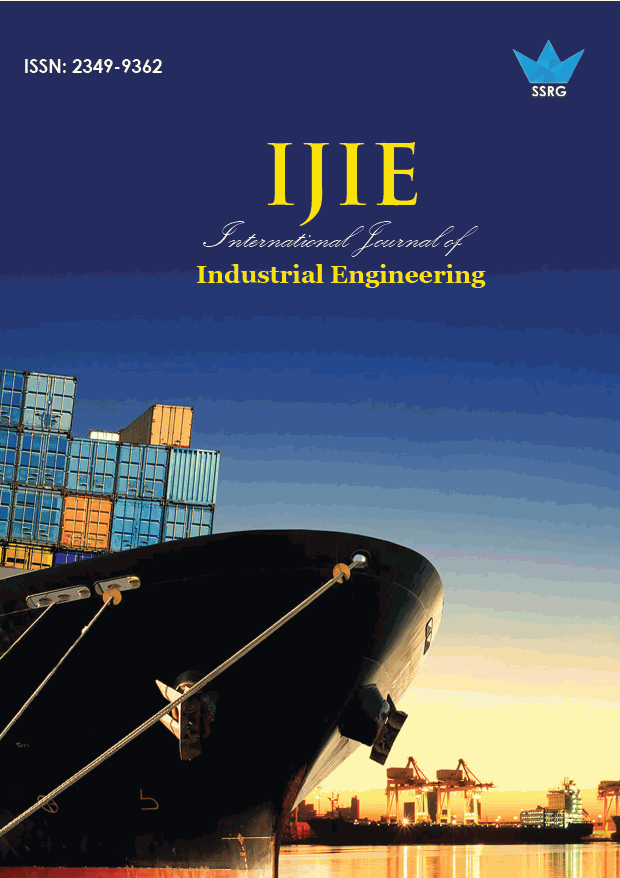Applying a People-Centric Reliability Method to Boost Productivity and Employee Well-being: A Case Study in the Marine Canvas Industry

| International Journal of Industrial Engineering |
| © 2025 by SSRG - IJIE Journal |
| Volume 12 Issue 2 |
| Year of Publication : 2025 |
| Authors : Isabella Tonani Montanhez, Carolina Menditi Silva, Guilherme Zuccolotto |
How to Cite?
Isabella Tonani Montanhez, Carolina Menditi Silva, Guilherme Zuccolotto, "Applying a People-Centric Reliability Method to Boost Productivity and Employee Well-being: A Case Study in the Marine Canvas Industry," SSRG International Journal of Industrial Engineering, vol. 12, no. 2, pp. 71-76, 2025. Crossref, https://doi.org/10.14445/23499362/IJIE-V12I2P108
Abstract:
This case study addresses the challenge of increasing throughput without significant capital investment by applying the Sawhney people-centric framework in a marine canvas company. This approach integrates Systems Thinking and Lean to enhance resource reliability through employee-centered strategies. A diagnostic phase, including time studies and reliability assessments, identified critical bottlenecks, workload imbalances, and high non-value-added activities rooted in human and informational reliability. In response, two line balancing strategies were developed. A no-cost personnel reallocation projected a roughly 56% productivity increase (from 16 to 25 units/day), while a modest investment in two additional workers could raise output by approximately 162% (to 42 units/day). Beyond these operational gains, the strategies also reduce employee stress and improve process stability. This study distinguishes itself from much of the existing Lean and Operational Excellence literature by offering an empirical application of a people-centric reliability framework in a small, high-mix, manual production environment. This demonstrates that a people-centric approach offers a powerful, low cost pathway to sustainable operational Excellence in manufacturing, directly addressing the gap between theoretical human-centric paradigms (e.g., Industry 5.0) and practical, low-capital implementation.
Keywords:
Lean Manufacturing, Line Balancing, Operational Excellence, People-Centric Reliability, Productivity Improvement.
References:
[1] Thomas L. Quick, “Healthy Work: Stress, Productivity, and the Reconstruction of Working Life,” National Productivity Review, vol. 9, no. 4, 1990.
[Google Scholar] [Publisher Link]
[2] Wilmar B. Schaufeli, and Arnold B. Bakker, “Job Demands, Job Resources, and Their Relationship with Burnout and Engagement: A Multi-Sample Study,” Journal of Organizational Behavior, vol. 25, no. 3, pp. 293–315, 2004.
[CrossRef] [Google Scholar] [Publisher Link]
[3] James P. Womack, Daniel T. Jones, and Daniel Roos, The Machine That Changed the World: The Story of Lean Production, Free Press, 2007.
[Google Scholar] [Publisher Link]
[4] Jeffrey Liker, J. K., The Toyota Way: 14 Management Principles from the World's Greatest Manufacturer, McGraw-Hill, 2020.
[Google Scholar] [Publisher Link]
[5] Rapinder Sawhney et al., “A Conceptual People-Centric Framework for Sustainable Operational Excellence,” Open Journal of Business and Management, vol. 8, no. 3, 2020.
[CrossRef] [Google Scholar] [Publisher Link]
[6] Rapinder Sawhney, Febiano Carvalho de Castro Sene, and Ninad Pradhan, “People-Centric Systems Reliability Teaching Methodology at The University of Tennessee, Knoxville,” American Society for Engineering Education, 2021.
[Google Scholar] [Publisher Link]
[7] Charles E. Ebeling, An Introduction to Reliability and Maintainability Engineering, Waveland Press, 2019.
[Google Scholar] [Publisher Link]
[8] Taiichi Ohno, Toyota Production System: Beyond Large-Scale Production, Productivity Press, 1988.
[CrossRef] [Google Scholar] [Publisher Link]
[9] Mike Rother, and John Shook, Learning to See: Value Stream Mapping to Add Value and Eliminate Muda, 2nd Edition, Lean Enterprise Institute, 2003.
[Google Scholar] [Publisher Link]
[10] Yasuhiro Monden, Toyota Production System: An Integrated Approach to Just-In-Time, 4th Edition, CRC Press, 2011.
[Google Scholar] [Publisher Link]
[11] Nigel Slack, Alistair Brandon-Jones, and Robert Johnston, Operations Management, 8th Edition, Pearson, 2016.
[Google Scholar] [Publisher Link]
[12] Masaaki Imai, “Gemba Kaizen: A Commonsense, Low-Cost Approach to Management,” Das Summa Summarum des Management, pp. 7-15, 1997.
[CrossRef] [Google Scholar] [Publisher Link]
[13] John Bicheno, and Matthias Holweg, The Lean Toolbox: A Handbook for Lean Transformation, 5th Edition, PICSIE Books, 2016.
[Google Scholar] [Publisher Link]
[14] Shigeo Shingo, A Study of the Toyota Production System from an Industrial Engineering Viewpoint, Taylor & Francis, pp. 1-257, 1989.
[Google Scholar] [Publisher Link]
[15] Ismail Sila, and M. Ebrahimpour, “Examination and Comparison of the Critical Factors of Total Quality Management across Countries,” International Journal of Production Research, vol. 41, no. 2, pp. 235–268, 2003.
[CrossRef] [Google Scholar] [Publisher Link]
[16] Deborah J. Nightingale, and Jayakanth Srinivasan, Beyond the Lean Revolution: Achieving Successful and Sustainable Enterprise Transformation, AMACOM, 2011.
[Google Scholar] [Publisher Link]
[17] Peter Hines, Matthias Holweg, and Nick Rich, “Learning to Evolve: A Review of Contemporary Lean Thinking,” International Journal of Operations & Production Management, vol. 24, no. 10, pp. 994–1011, 2004.
[CrossRef] [Google Scholar] [Publisher Link]

 10.14445/23499362/IJIE-V12I2P108
10.14445/23499362/IJIE-V12I2P108